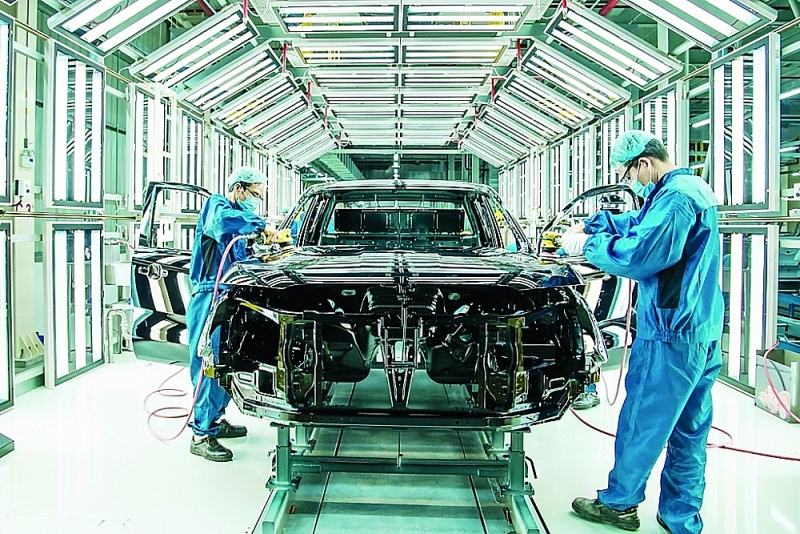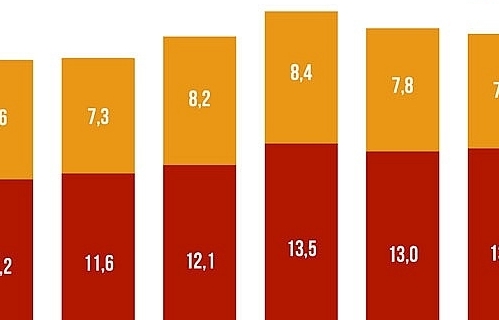Incentives for development of auto industry
 |
| The incentive program supports the development of domestic automobile production. Photo: Nguyen Ha |
Reduce taxes and fees
The year 2018 was the time to carry out commitments on reducing import tax on CBU cars in the ASEAN region to 0%, while domestic auto production was gloomy.
At that time, the Ministry of Industry and Trade reported localization rate of less than 9-seater cars is only 7-10% on average; new production stops at simple assembly and production line; car prices in Vietnam are two times higher than those of regional countries; and the quality of locally-assembled and manufactured cars is not as good as imported ones.
If the State does not develop incentive policies, local cars cannot compete with imported products.
Therefore, the Government issued Decree 125/2017 and Decree 57/2020 to run the tax incentive program for auto production and assembly. Accordingly, enterprises that meet the conditions set out in the incentive program are entitled to the preferential import tax rate of 0% for imported auto parts that cannot be produced domestically.
In addition, the Prime Minister signed Decree 70/ND-CP, effective from June 28 to December 31, 2020, to reduce 50% of the registration fees for domestically manufactured and assembled cars to encourage domestic car consumption and production. Accordingly, State revenue reduced by VND3,700 billion.
The result is not commensurate with State’s incentive policies
Although the Government issued preferential policies, the auto industry still has many limitations.
The Ministry of Finance said Vietnam's auto industry is currently only participating in the low segment of the auto value chain and greatly relies on the production of global automobile corporations. It has not yet mastered core technologies such as engines, control and motion systems.
The auto manufacturing and assembly industry has also not yet created the cooperation and specialization between enterprises in auto manufacturing and assembling and auto part production; and has not built a system of large suppliers of auto materials and auto parts.
Moreover, the auto manufacturing and assembly industry has not reached the goal of raising the localization rate, especially for less than 9-seater cars. In fact, the localization rate has grown mainly in the bus and truck lines.
In particular, despite the State's preferential policies, Vietnam’s selling price of cars is still higher than other regional countries. Therefore, the target of improving competitiveness and reducing imports has not been achieved as expected.
As of July 15, auto imports gained more than US$2 billion (up 107.7% over the same period last year).
The Ministry of Industry and Trade said the auto market size and the price difference between domestically produced cars and imported cars are the two biggest problems and challenges that Vietnam’s auto industry is facing.
Currently, Vietnam's auto market size is only a third of Thailand's and a quarter of Indonesia's.
This is a setback, so to participate in the incentive program, enterprises must satisfy the productivity condition. However, this condition was apparently not fulfilled.
Continue expecting incentive policies
The five-year incentive program is going to end and there are many shortcomings and inadequacies, the domestic auto industry is facing fierce competition from imported cars (from ASEAN members, CPTPP members and EVFTA members in next seven to ten years).
Many proposals have been made to support domestic auto production, mainly proposals on policy incentives.
The Ministry of Finance is consulting other ministries and sectors on expanding the tax incentive program after 2022.
Agreeing with the Ministry of Finance’s proposal, the Ministry of Industry and Trade also proposes revising regulations on special consumption tax for cars.
In an interview with reporters, a representative of the Department of Industry under the Ministry of Industry and Trade affirmed his support for the continuation of the tax incentive program.
The incentive program can be a lever to help domestic automobile enterprises overcome difficulties, improve competition with imported cars, and contribute to the development of the auto industry. The issuance of preferential policies is necessary.
However, after three years of implementing preferential policies, besides achievements, the auto industry still has many weaknesses and many problems.
Therefore, along with preferential policies, there must have reasonable conditions for the auto industry to achieve set goals.
Related News

Agricultural, forestry and fishery exports “reach the target” early
15:20 | 19/12/2024 Import-Export

The way for Vietnamese goods in the e-commerce race
11:08 | 30/11/2024 Import-Export

Sustainable production will bring advantages to Vietnamese pepper and spices
13:44 | 06/12/2024 Import-Export

Exporting via e-commerce: Hesitation leads to missed opportunities
11:09 | 30/11/2024 Import-Export
Latest News

VN faced with increasing trade defence investigations on rising protectionism
18:58 | 22/12/2024 Import-Export

Việt Nam expects to officially export passion fruit to the US next year
18:55 | 22/12/2024 Import-Export

UK’s carbon tax to affect VN exports
18:51 | 22/12/2024 Import-Export

Removing obstacles in granting certificates of exploited aquatic products
13:56 | 22/12/2024 Import-Export
More News

Promoting agricultural exports to the Japanese market
13:55 | 22/12/2024 Import-Export

Agricultural exports in 2024 to exceed 60 billion USD?
13:53 | 22/12/2024 Import-Export

Seafood exports expected to exceed $10 billion in 2025: expert
20:28 | 21/12/2024 Import-Export

Top 10 Reputable Animal Feed Companies in 2024: Efforts to survive the challenges of nature
18:30 | 21/12/2024 Import-Export

Vietnam's import-export surges 15.3%
09:44 | 20/12/2024 Import-Export

More Vietnamese firms interested in Saudi Arabia: Ambassador
09:43 | 20/12/2024 Import-Export

“Give and Take” in the Value Chain of the CPTPP Market
09:30 | 20/12/2024 Import-Export

Binh Dinh province works to attract investment from Japan
15:44 | 19/12/2024 Import-Export

Thailand remains Vietnam’s biggest trading partner in ASEAN
15:35 | 18/12/2024 Import-Export
Your care

VN faced with increasing trade defence investigations on rising protectionism
18:58 | 22/12/2024 Import-Export

Việt Nam expects to officially export passion fruit to the US next year
18:55 | 22/12/2024 Import-Export

UK’s carbon tax to affect VN exports
18:51 | 22/12/2024 Import-Export

Removing obstacles in granting certificates of exploited aquatic products
13:56 | 22/12/2024 Import-Export

Promoting agricultural exports to the Japanese market
13:55 | 22/12/2024 Import-Export





